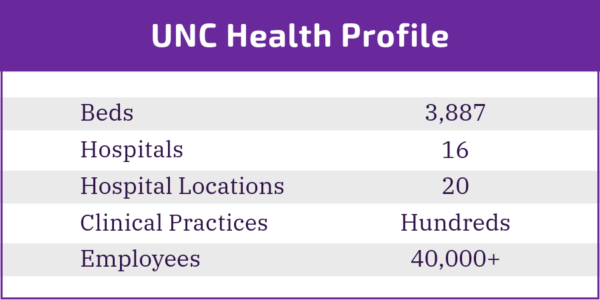For hospitals and health systems, the challenges posed by the constant churn of EHR and third-party application testing are significant and far-reaching. Manual testing devours IT employee hours and prevents analysts from negotiating more complex tasks, which hurts team morale and the overall efficiency and performance of the healthcare organization. In addition, the potential for human error and testing failures can potentially impact everything from patient safety to financial outcomes.
In this three-part blog series, we explore the uphill battle being waged by hospitals and health systems as they try to overcome the challenges posed by manual application testing. To provide real-world context, we’ll focus on the journey of UNC Health, North Carolina’s largest healthcare system, and the lessons learned as they tried to implement an in-house, automated testing system after a period of unprecedented acquisition and growth.
Lastly, we’ll uncover the methodology SureTest, a top-managed test automation solution provider, utilized to help UNC Health implement the automated testing library and managed solution frameworks they required. It’s a comprehensive, five-part “playbook” that can inform other hospitals and health systems in similar circumstances.
The UNC Health Experience
Addressing the Problem
If you are an IT leader for a hospital or health system responsible for EHR, third-party, and enterprise application testing processes for system upgrades and new implementations, this article is for you. If you are a member of a hospital or health system’s executive team, you will want to read this article to support your IT colleagues.
Let’s start with a short checklist SureTest typically asks hospital IT leaders across the country:
- Does EHR and third-party or enterprise application testing take too much of your team’s time and too much of a bite out of your budget?
- Do the thousands of hours of testing each year detract from your team’s ability to get to more strategically pressing priorities across the enterprise?
- Are the hours demanded for testing impacting the job satisfaction of your IT team?
- Do the serious implications of potential testing failures on patient safety, operational efficiencies and financial performance keep you up at night?
If you answered yes to any of those questions, keep reading because in short order we outline clear solutions and do so by sharing the experience of one of the leading health systems in the U.S. and the largest in North Carolina – UNC Health.

Problems and Risks of Testing
They say that there are two things in life that are sure: death and taxes. For hospital IT teams, however, there’s a third: the never-ending barrage of script changes for EHR applications that need to be tested. It is usually a tangled, complex, and high-risk challenge that must be performed with precision across the thousands of touch points where those script changes impact the patient, the operation, and the financial health of the entire health system enterprise.
No members of a hospital IT team should feel alone because they share these three common challenges that every single hospital must grapple with and solve, all of which are intertwined with application testing:
External Forces Outside IT’s Control Create Substantial Headwinds | Exponentially increasing demands on IT resources in the face of diminishing budget resources. Lengthy testing cycles that unnecessarily sap resources and delay go-live and release target dates. Growth through acquisitions requiring EHR platform and third-party testing integrations (see The UNC Health Challenge). |
Internal Dynamics and Limitations Make it Too Difficult to Keep Up | Manual testing in whole, or in part, can’t possibly keep pace with the sheer volume of testing demands. In-house-developed test automation and internal staff to continually maintain the automation scripts falling way short of volume demand. Addressing staff satisfaction, their own career expectations and aspirations, morale and burnout that come with substandard testing infrastructure. |
Required Baseline Capabilities Growing More Complex and Demanding | The ability to precisely emulate end-user experiences, account for every patient journey, and validate workflow integrity from front to back at every turn across the enterprise. Access to industry standard testing scripts proven to effectively eliminate the need to repeatedly reinvent the wheel. Continual testing across workflows even amid system change. Real-time audit documentation to ensure effectiveness and compliance. Finding and fixing broken scripts and removing clunky workarounds that invite risk. |
Hospital system innovator, UNC Health, recognized those challenges and risks and sought to shift from manual system testing to a full-service managed test automation solution. That was the start of an important automation journey that ultimately became a best practices roadmap for why and how to implement test automation.
“As a recognized health system leader nationally, UNC Health brings the vision and strategy, the talent and expertise, the infrastructure and organization to everything they do,” said Laura O’Toole, CEO of SureTest, the company behind SureManage®, the intelligent application test automation solution for hospitals and health systems. “When we first started working together, what struck me most was how dedicated the UNC Health team was to make certain that they were delivering best practices and at the same time recognizing the huge challenges that testing poses for all healthcare organizations.”
Up Next: UNC Health’s Journey
Part One of this three-part series outlined the sizable application testing challenges facing hospitals, and in particular, their IT teams. The relentless demand and volume of the testing required, coupled with budget constraints and inadequate testing infrastructures, can create inefficiency, frustration, and undue strain on the entire organization.
In Part 2, we’ll examine UNC Health’s journey through an unprecedented period of growth and how their transition from manual testing to an in-house automated solution and then to a partnership with SureTest transpired. UNC Health’s experience provides invaluable insights and a roadmap for other healthcare organizations considering the same path.

